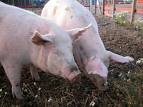New Wave of Disinformation: “Pigs at Risk” of Contracting the H1N1 Swine Flu

“Pigs at risk from people as new flu spreads” citing authoritative scientific sources is the title of a recent news report. “With the increasing numbers of human infections, a spillover of this virus to pigs is becoming more likely.”
Pigs are the victims. Humans are the perpetrators. In a twisted logic, the news reports convey the impression that only people can infect pigs with the H1N1 swine flu and that pigs cannot be the original source of the infection.
The reports also convey the impression that hog farms are clean and that the swine flu is not endemic to the hog farms:
“German scientists are warning of a pig pandemic after tests suggested the swine flu can pass from humans to hogs and then infect a whole herd.
A team of virologists at Germany’s national animal health research lab recently infected five pigs with the human strain of the H1N1 virus and put the sick pigs in a room with three healthy pigs.
Within four days, all the pigs had the flu. All of them recovered.
A research paper to be published Friday in the Journal of General Virology warns “the high transmissibility of the virus observed in humans also applies to pigs.”
That increasingly puts pigs at risk as the virus spreads among humans.
“It must be assumed that this virus will spread fast and efficiently if introduced into swine farms, possibly establishing endemic infections,” the paper says.
“With the increasing numbers of human infections, a spillover of this virus to pigs is becoming more likely.”
There is no evidence pigs are passing the swine flu virus to humans, or that eating pork products poses an infection risk.
Dr. Thomas Vahlenkamp, who headed the team of virologists at Germany’s Friedrich Loeffler Institute, said the tests show how susceptible pigs are to the virus.
“We would not claim that the virus can easily be transmitted to pigs,” he said.
“But at least if the pig is infected, it can transmit it quite easily between pigs.”
…
This is not the first time researchers have shown pigs can catch the human strain of the H1N1 virus. British scientists ran similar tests in May with the same results.
But it’s believed the German scientists are the first to publish their findings in a scientific journal.
….
Canada is only one of two places where the pandemic virus has been found in pigs. The other is Argentina.” (Canadian Press, July 9, 2009, emphasis added)
The German report also suggests that pigs are at risk to contract the virus from humans, and should be vaccinated to avoid the spread of the virus among the pig population:
The German scientists say experiments are underway to see whether there are any vaccines available for pigs that might stop the spread of the swine flu. (Ibid)
The report blatantly contradicts itself in claiming that human to pig transmission is the main causal factor:
“In April, swine flu appeared in pigs on an Alberta farm. At first, health officials thought a farmhand who had been to Mexico and fell ill upon his return infected the pigs. But blood tests showed the worker didn’t infect the herd. (Ibid, emphasis added)
The report refers to a Canadian hog farm in Alberta where more than 200 animals were infected with the H1N1 virus in a single hog farm. (For further details see Michel Chossudovsky,The A H1N1 Pandemic: Pig to Human Transmission of the Swine Flu? Global Research, May 15, 2009).
The incident was covered up. The facts were distorted. Health authorities initially stated that it was a Mexican farm worker who infected the pigs.
It was, however, established that human to pig transmission was not the cause.
SO WHAT WAS THE CAUSE? More precisely if humans are not the source of infection of the pigs, who is the source of the infection? Where did the virus infection originate? This question was carefully sidestepped both by Canadian health officials and the media.
If more than 200 animals are infected with H1N1 virus on a single hog farm, does this not suggest that the virus was endemic to that particular hog farm.
The pigs were subsequently culled to “kill the evidence”
There are indications that pigs in North American hog farms, as evidenced by the Alberta hog farm, could be infected with the H1N1 strain and that this is not the result of human to pig transmission.

